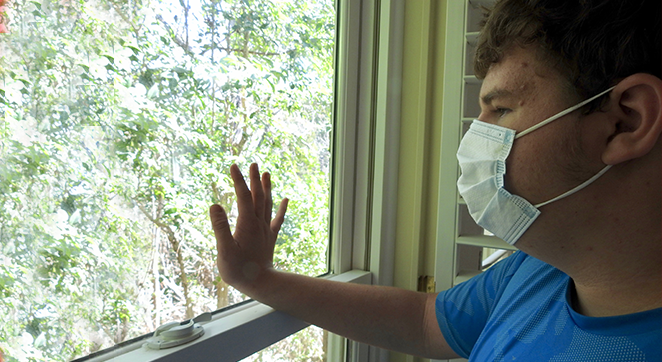Isolation can be hazardous for your health: People with disabilities in closed settings during COVID
Written by Maggie Suter
The author, Maggie Suter, is a Disability Services Educator/Trainer with SAFE. SAFE provides a variety of classes for people with intellectual and developmental disabilities, including holistic healing classes to learn coping skills and strategies to reduce stress.
Imagine living in a closed setting, such as a nursing home or an institution, and being a person with a disability. The COVID-19 pandemic arrives and suddenly the small pieces of the outside world you were a part of disappear. Visits with family, day programs, or any other activities outside your residence are prohibited. Visitors are limited or prohibited. Community activities and classes cease, as do the interactions you had with outside people. Access to transportation and going to work are nearly impossible.
It’s considered too dangerous, because as a person with a disability, you face a heightened risk of contracting COVID-19 due to underlying health conditions. Plus, it can be hard to enforce social distancing by other residents and staff necessary for tasks such as bathing and dressing.
Suddenly your world is very small, too small, and you feel isolated and alone.
This is the reality for millions of people
Roughly 1 in 4 adults in the U.S. has a disability, and an estimated 60% of Americans have at least one chronic health condition that could make the symptoms of COVID-19 more severe or deadly.
Mayra (not her real name) lives in a residential setting for people with intellectual and developmental disabilities. She has a roommate
When asked how the pandemic has affected her life, Mayra sighed and said: “Well we can’t hardly go nowhere. We stay six feet away all the time. I can’t go home to visit my family because they are old and COVID is too dangerous.”
The strict precautions are slowly loosening up and some residents will be able to return to work. Soon, as long as they get a negative COVID-19 test first, one visitor at a time will be able to visit a resident.
There has been more interpersonal violence among people in their group setting since the pandemic began, Mayra said. Residents are tired of each other and feel cramped, which has resulted in some scuffles. Some residents have died of COVID-19, and along-time staff member who many of the residents were close to.
Mayra says she’s depressed and has felt like she was “in a dark tunnel going on forever.” Since all of the residents will soon get their first dose of the vaccine she said she can now see a tiny light at the end of that dark tunnel.
Loneliness and isolation bring their own health risks: high blood pressure, heart disease, weakened immune system, depression, and anxiety.
Mayra’s feelings of isolation are not unique. People with disabilities do report feeling isolated from connections with other people, but COVID-19 has exacerbated the situation. People with disabilities often lack easy access to cell phones, the internet, and social media. Or, if they do have access, time allowed for use may be very limited and many have a hard time navigating websites and social media.
During the pandemic, caregivers, friends, and family members have mostly been unable to visit, and staff members—who were already hard to come by—are disappearing.
Staff shortages
At one Texas state supported residence, about a third of staff positions are currently unfilled. This large center houses people with intellectual and developmental disabilities and was an early hot spot as the virus began to spread.
Many of the residents at these facilities are medically fragile, which makes managing any outbreak even more difficult. Francisco Santillan, a labor organizer for the Texas State Employees Union, said that he has heard from numerous employees who are concerned about the ongoing staffing shortages.
“They don’t have enough staff to take care of those clients properly,” said Santillan, who previously worked at a residential facility. “The staff who are there are working incredible amounts of overtime and they are burned out. It’s not good for this vulnerable population.” In another large residential center in Texas, more than 150 residents with disabilities and about 40 staff are infected with COVID-19. Some of their residents have also died.
With conditions like this, people in large institutional type residences face greater risks of neglect, restraint, isolation, and abuse. The closed setting and strict COVID-19 protocols means that visitors to the group residential centers who would have ordinarily be available to support residents and recognize signs of abuse or neglect are no longer coming. “What this pandemic is putting a very fine point on right now is the fact that small and large congregate residential settings can be a public health hazard to people with disabilities,” said Nicole Jorwic, Senior Director of Public Policy at The Arc, an organization that supports people with intellectual and developmental disabilities.
Nicole also said, “What we need to do is provide more access to home and community-based services, so that they are not only integrated in their homes and communities as they should be, but also so that they are safe.”
SAFE also recognizes the need to offer more community based services and to continue to work collaboratively with residential service providers to offer educational and therapeutic activities that support healing and recovery (traditional and holistic) from the COVID related traumatic stressors (e.g., isolation, death of family members or staff or room-mates, depression, loss of jobs or other connections in the community, etc.).
If you need support, you can contact the 24/7 SAFEline: Call: 512.267.SAFE (7233) | Text: 737.888.7233 | SAFEline chat